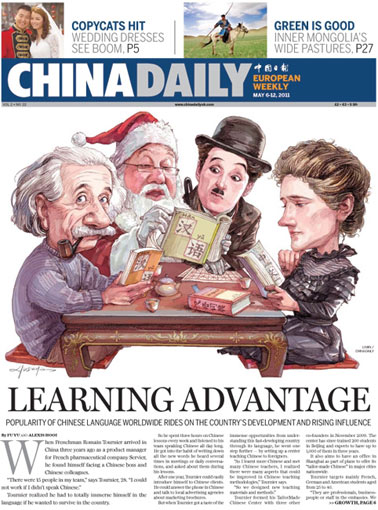Web Comments
Chinese market drives me crazy
Updated: 2011-05-05 10:58
By Geeta Kochhar (chinadaily.com.cn)
The market is driven by competition, and increased competition breaks monopolies. In any ideal market environment, this rule of thumb plays an important role. With Chinese market moving head on and forcing fierce competition internationally, many eyebrows are raised and voices of concern put forth. The "China Threat" theory escalated tension among the neighboring countries of China and sent jitters to many across the world. Yet, Chinese products are hot in demand in the international market. The competitive edge of prices, along with smart negotiating skills, Chinese products have taken over many competitors globally. Domestically, Chinese market has come a long way to achieve the present-day miracle. From an isolated economy to enhanced foreign market penetration, numerous doors and windows have been opened. Many bureaucratic obstacles have been removed, and preferential policies were designed to reshape the Chinese market. Today, the name "CHINA" runs high in all international trading.
The immense variety of products boggles ordinary people within China and those visiting China. Not only do the products lie in uncountable numbers, the shops and shopping malls have also multiplied. Enter, say, Tianyi market of Beijing, a wholesale shopping area for small commodities. Everywhere one looks, similar products with unimaginable variety and numbers flood the vision. You take a deep breath to make up your mind, where to start. Same is the case at other commercial areas of Beijing, such as Zhongguancun, high-tech products center; Dongwuyuan area for clothes; Haidian Tushucheng for books; Beiyayuncun market for cars, and the list goes on. Same is the case with other cities such as Shanghai, Guangdong, Hangzhou, Yiwu… In addition, there are secondhand markets for everything. More important is the fact that all tourist destinations are extremely commercialized, with shops for anything and everything. In addition, the trend of chaoshi (超市 supermarkets) for daily products has taken a front row for the ordinary Chinese. All this is happening even with the noises about soaring prices of essential commodities and concerns for increased inflation rates.
The Internet has also become a major place for trading of various products in China. Many sites have attracted the attention of Chinese consumers, especially the younger generation, to buy products online. It saves them the hassle of going to the market in heavy traffic jams. Moreover, time is not a factor for Internet buying and selling; while many wholesale commodity markets put their shutters down by 5:30 p.m. Internet sites also provide discounted products and ease of comparison. Sites like taobao (淘宝) for general products, dangdang (当当) for books, elong (艺龙) for travel and tour; dianping (大众点评) for eateries, are hot favorites. There are also sites that run products for secondhand sale or free gifting of used products, like ganji (赶集).
An important factor driving the Chinese market is the political slogan "March with the times" (与时俱进). Any new innovation across the globe or any new product that enters the international market is available in China in no time. In addition, look-alikes or more sophisticated local versions flood the markets within days. What sells hot internationally, especially in the Western world, makes bigger waves in the domestic Chinese market; while cheap local Chinese products have potential buyers internationally. The only problem in this cat and mouse game is the quality standards. The issue of poor quality of Chinese products became a concern for many countries and within China serious cases have been reported, questioning the quality of products. However, authorities are now up in arms to severely protect the image of the "brand China" tag.
In order to protect the image and standards of Chinese products, Chinese leaders have put in a special drive to emphasize "innovation" (创新). Until very recently, Chinese products were known for their cheaper prices, but now the stress is on quality. A probable shift for Chinese market would be from "Made in China" to "Made by China". Although there is still a long way to go, the Chinese are determined to prove to the world, "yes, I can do it". It seems not long before they will be able to march ahead with bigger steps. The only problem may be the shortage of a skilled labor force along with the decline in a young labor force. According to some reports, by 2050 the number of people above 60 is estimated to reach 400 million and the population above 80 will be 100 million. Besides, there will be a drastic decline in the active labor force, age 18 to 35. These issues will be of greater concern to China, if it has to continue to take the leverage of a competitive economy. However, for the time being Chinese market rules all the games and drives many people crazy.
Dr. Geeta Kochhar is a Visiting Fellow at Chinese Academy of Social Sciences in Beijing. She is an Assistant Professor at the Center for Chinese & South-East Asian Studies, School of Language, Literature & Culture Studies, Jawaharlal Nehru University in New Delhi, India.
E-paper

Head on
Chinese household care goods producers eye big cities, once stronghold of multinational players
Carving out a spot
Back onto center stage
The Chinese recipe
Specials

Bin Laden dead
The world's most wanted man was killed in a US raid in Pakistan.

British Royal Wedding
Full coverage of the royal wedding of Prince William and Kate Middleton in London. Best wishes

The final frontier
Xinjiang is a mysterious land of extremes that never falls to fascinate.
